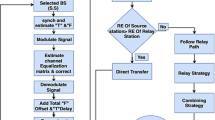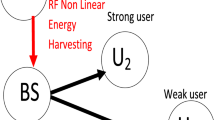Abstract
To evaluate the performance of cognitive radio (CR) under the energy detection scheme, the proper selection of threshold is an important and a critical task. The threshold is generally selected, either under a target probability of detection \((\overline{P_d})\) called as the constant detection rate (CDR) principle, or under the target probability of false alarm \((\overline{P_{fa}})\), called as the constant false alarm rate (CFAR) principle. To ensure sufficient protection to the licensed users (or primary users), the selection of threshold under the CDR principle is best suited. This paper discusses and analyzes the inefficiency of CR under the blind use of CDR principle, mainly, when primary receiver is located at a sufficient distance d from the secondary transmitter where signal to interference plus noise ratio (SINR) is larger than a cut-off value \(SINR_{th}\) (which is a minimum SINR required to properly decode the intended information of primary user). To overcome this inefficiency, we propose an approach which while considering distance d between the secondary transmitter and primary receiver as an important parameter, makes an interference-aware selection of threshold based on the CDR and CFAR principles. Under the proposed approach, the CR system achieves a significant gain in its throughput even under the low signal to noise ratio conditions.











Similar content being viewed by others
Notes
Based on the settings of various parameters assumed (assumptions are given in Sect. 5), the value of critical distance \(d_c\) may vary.
As per the properties of the Q function Q(x), it shows sharp variation for a given range of x, as \(x\epsilon ({-4, 4})\), however, beyond this range, the variations are negligible. So, this results in an un-noticeable variation to the achieved simulation curves (for some range of variable on x-axis), as depicted in Figs. 2 and 3.
During sensing, the distance between the secondary transmitter and primary transmitter (\(d_{ps}\)) may also be computed as follows: The term \(P_{rps}\) in Eq. (21) shows the power of primary transmitter received at the sensing node (i.e. secondary transmitter). Since, the values \(P_{rps}\), \(P_p\), r and the constant c are already known at the CR end, the distance \(d_{ps}\) can be computed as:
$$\begin{aligned} d_{ps} =exp\left( {\frac{1}{r}.ln\left( {c.\frac{P_p}{P_{rps}}} \right) } \right) \end{aligned}$$
References
Mitola, J., & Maguire, G. Q. (1999). Cognitive radio: Making software radio more personal. IEEE Personal Communications, 6(4), 13–18.
Mitola, J. (2000). Cognitive radio: An integrated agent architecture for software defined radio. PhD. Dissertation, Royal Institute of Technology (KTH), Stockholm.
Ghasemi, A., et al. (2007). Fundamental limits of spectrum-sharing in fading environments. IEEE Transactions on Wireless Communications, 6(2), 649–658.
Pandit, S., & Singh, G. (2013). Throughput maximization with reduced data loss rate in cognitive radio network. Telecommunication Systems, 57, 209–215. doi:10.1007/s11235-013-9858-z.
Stotas, S., & Nallanathan, A. (2011). Optimal sensing time and power allocation in multiband cognitive radio networks. IEEE Transactions On Communications, 59(1), 226–235.
Kaur, P., Uddin, M., & Khosla, A. (2012). Throughput analysis for opportunistic spectrum access among unlicensed devices. In National conference on communications (NCC) (pp. 1–5). doi:10.1109/NCC.2012.6176818.
Federal Communications Commission. (Nov. 2002). Spectrum policy task force report. FCC 02–155.
Haykin, S. (2005). Cognitive radio: brain-empowered wireless communications. IEEE Journal on Selected Areas in Communications, 23, 201–220.
Liang, Y.-C., et al. (2008). Sensing-throughput tradeoff for cognitive radio networks. IEEE Transactions on Wireless Communications, 7(4), 1326–1336.
Altrad, O., et al. (2014). Opportunistic spectrum access in cognitive radio networks under imperfect spectrum sensing. IEEE Transactions on Vehicular Technology, 63(2), 920–925.
Digham, F., et al. (2007). On the energy detection of unknown signal over fading channels. IEEE Transactions on Communications., 55(1), 21–24.
Altrad, O., & Muhaidat, S. (2013). A new mathematical analysis of the probability of detection in cognitive radio over fading channels. EURASIP Journal on Wireless Communications and Networking, 2013, 1–11.
Du, K. L., & Mow, W. H. (2010). Affordable cyclostationary-based spectrum sensing for cognitive radio with smart antennas. IEEE Transactions on Vehicular Technology, 59(4), 1877–1886.
Kay, S. M. (1998). Fundamentals of statistical signal processing. Volume 2: Detection theory. Upper Saddle River, NY: Prentice-Hall.
Ma, J., et al. (2008). Soft combination and detection for cooperative spectrum sensing in cognitive radio networks. IEEE Transaction on Wireless Communications, 7(11), 4502–4507.
Choi, H.-H., et al. (2008). Adaptive sensing threshold control based on transmission power in cognitive radio systems. In IEEE conference on cognitive radio oriented wireless networks and communication (CrownCom) (pp. 1–6).
Wang, N., et al. (2013). Adaptive spectrum sensing algorithm under different primary user utilizations. IEEE Communications Letters, 17(9), 1838–1841.
Mariani, A., et al. (2011). Effects of noise power estimation on energy detection for cognitive radio applications. IEEE Transactions on Communications, 59(12), 3410–3420.
Ye, Z. et al. (2008). Energy detection using estimated noise variance for spectrum sensing in cognitive radio networks. In IEEE wireless communications and networking conference (WCNC) (pp. 711–716).
Peh, E., & Liang, Y.-C. (2007). Optimization for cooperative sensing in cognitive radio networks. In IEEE wireless communications and networking conference (WCNC) (pp. 27–32).
Singh, N. T. & Singh, B. J. (2014). Performance improvement in sensing error probability for low SNR scenarios in cognitive radio networks. In IEEE international conference on recent advances and innovations in engineering (ICRAIE) (pp. 1–4).
Cabric, D., et al. (2006). Experimental study of spectrum sensing based on energy detection and network cooperation. In Proceedings of the international technology and policy for accessing spectrum.
Moghimi, F., et al. (2009). Lp-norm spectrum sensing for cognitive radio networks impaired by non-gaussian noise. In Proceedings of the IEEE conference GLOBECOM (pp. 1–6).
Stotas, S., & Nallanathan, A. (2011). Enhancing the capacity of spectrum sharing cognitive radio networks. IEEE Transactions on Vehicular Technology, 60(8), 3768–3779.
Verma, G., & Sahu, O. P. (2015). Interference aware optimization of throughput in cognitive radio system. Defence Science Journal, 65, 312–318.
Verma, G., & Sahu, O. P. (2015). Throughput enhancement to the cognitive radio networks under the precaution is better than the cure approach (PBC). In Proceedings of the IEEE international conference on signal processing and communication engineering systems (SPACES) (pp. 1–4). Vijayawada: K.L. University.
Verma, G., & Sahu, O. P. (2015). Throughput enhancement to the cognitive radio networks under the precaution based cooperation of the primary users. In Proceedings of the IEEE international conference on signal processing, informatics, communication and energy systems (SPICES) (pp. 1–4). Calicut: NIT Calicut.
Lin, Y.-E., et al. (2013). On using interference-aware spectrum sensing for dynamic spectrum access in cognitive radio networks. IEEE Transactions on Mobile Computing, 12(3), 461–474.
Kan, C., et al. (2013). Optimization of cooperative sensing in interference-aware cognitive radio networks over imperfect reporting channel. In IEEE international conference on wireless communication and signal processing (WCSP) (pp. 1–6).
Dubey, R. K., & Verma, G. (2015). Improved spectrum sensing for cognitive radio based on adaptive threshold. In IEEE international conference on advances in computing and communication engineering (ICACCE) (pp. 253–256).
Benitez, M. L., et al. (2013). Signal uncertainty in spectrum sensing for cognitive radio. IEEE Transactions on Communications, 61(4), 1231–1241.
Benitez, M. L., et al. (2010). Performance of spectrum sensing for cognitive radio based on field measurements of various radio technologies. In IEEE international conference on European wireless (EW) (pp. 969–977).
Lehtomaki, J. J., et al. (2007). CFAR outlier detection with forward methods. IEEE Transactions on Signal Processing, 55(9), 4702–4706.
Hamdi, K., et al. (2007). Power control in cognitive radio systems based on spectrum sensing side information. In International conference on communications (ICC) (pp. 5161–5165).
Dubey, R. K., & Verma, G. (2015). Improved spectrum sensing for cognitive radio based on adaptive double threshold. International Journal of Emerging Trends in Electrical and Electronics (IJETEE), 11(2), 1–6.
Nasreddine, J., et al. (2010). Location-based adaptive detection threshold for dynamic spectrum access. In IEEE symposium on new frontiers in dynamic spectrum (pp. 1–10).
Kan, C., et al. (2012). Sensing-throughput tradeoff for interference-aware cognitive radio networks. In IEEE international conference on computer science and network technology (ICCSNT) (pp. 660–665).
Werner, J., et al. (2013). Estimating the primary user location and transmit power in cognitive radio systems using extended kalman filters. In IEEE international conference on wireless on-demand network systems and services (WONS) (pp. 68–73).
Radhi, N., et al. (2011). Estimate primary user localization using cognitive radio networks. In IEEE international conference on innovations in information technology (IIT) (pp. 381–385).
Wang, J., et al. (2010). Weighted centroid algorithm for estimating primary user location: theoretical analysis and distributed implementation. arXiv:1011.2313 (pp. 1–25).
Wild, B., et al. (2005). Detecting primary receivers for cognitive radio applications. IEEE symposium on new frontiers in dynamic spectrum access networks (DySPAN) (pp. 124–130).
Xiao, L., et al. (2007). Sensor-assisted localization in cellular systems. IEEE Transactions on Wireless Communications, 6(12), 4244–4248.
Huang, T., & Li, J. (2013). A weighted cooperative spectrum sensing scheme based on dynamic double energy thresholds in cognitive radio networks. In IEEE conference, global high tech congress on electronics (GHTCE) (pp. 201–204).
Author information
Authors and Affiliations
Corresponding author
Rights and permissions
About this article
Cite this article
Verma, G., Sahu, O.P. Intelligent selection of threshold in cognitive radio system. Telecommun Syst 63, 547–556 (2016). https://doi.org/10.1007/s11235-016-0141-y
Published:
Issue Date:
DOI: https://doi.org/10.1007/s11235-016-0141-y




